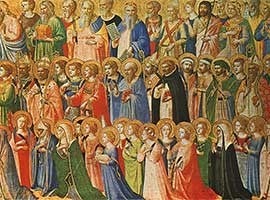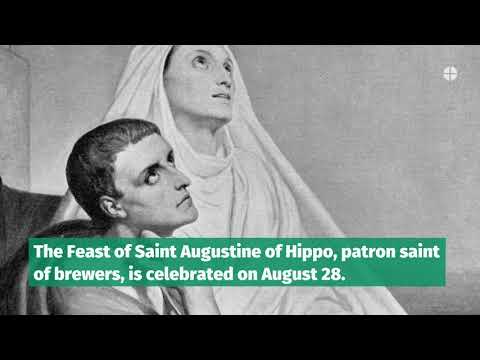Saints
Many popular devotional practices involve the veneration of the saints. The saints have a special place in the Body of Christ, which includes both the living and the dead. Through Christ, we on earth remain in communion both with the saints in heaven and with the dead who are still in Purgatory. We can pray for those in Purgatory and ask the saints to pray for us. Through their prayers of intercession, the saints in heaven play an integral role in the life of the Church on earth. "For after they have been received into their heavenly home and are present to the Lord, through Him and with Him and in Him they do not cease to intercede with the Father for us, showing forth the merits which they won on earth through the one Mediator between God and man." The saints, the members of the Church who have arrived at perfect union with Christ, join their wills to the will of God in praying for those in the Church who are still on their pilgrimage of faith.
American Saints & Blesseds
Saints Who Were Great Evangelizers
On the Road to Sainthood
Besides what the saints can do for us by their prayers, the very practice of venerating the saints does great good for those who are devoted to the saints. By practicing love of the saints we strengthen the unity of the entire Body of Christ in the Spirit. This in turn brings us all closer to Christ. "For just as Christian communion among wayfarers brings us closer to Christ, so our companionship with the saints joins us to Christ, from Whom as from its Fountain and Head issues every grace and the very life of the people of God." Love of the saints necessarily includes and leads to love of Christ and to love of the Holy Trinity. "For every genuine testimony of love shown by us to those in heaven, by its very nature tends toward and terminates in Christ who is the 'crown of all saints,' and through Him, in God Who is wonderful in his saints and is magnified in them."
—From Popular Devotional Practices
Beatification & Canonization
The process of declaring one a saint in the Catholic Church is called canonization. The canonization process is a canonical (Church law) procedure by which the Church through the Pope solemnly declares a Catholic to be united with God in heaven, an intercessory to God on behalf of the living, and worthy of public and universal veneration.
A cause of canonization examines a person’s life and death to determine if they were either martyred or lived a virtuous life. Every cause of canonization has two phases: the diocesan and Roman phase. The diocese responsible for opening a cause is the diocese in which the person died/was martyred. The diocese, religious order, association or lay person(s) requesting (petitioning) for the cause asks the diocesan bishop, through a person known as the postulator to open an investigation into the martyrdom or life of the person.
The diocesan bishop investigates how the person lived a heroic virtuous life, exemplifying the virtues of faith, hope and love through the calling of witnesses and the theological examination of the candidates’ writings. If the cause is based on martyrdom, the diocesan bishop investigates the circumstances surrounding the alleged martyrdom, which is also done through the calling of witnesses to the martyrdom and the examination of the candidates’ life.
Once the diocesan investigation is complete, the documentation (evidence) that has been collected is sent to the Vatican’s Congregation for the Causes of Saints and the Roman phase begins. The first step in the Roman phase is the examination of the diocesan documentation. If the congregation’s theologians find the documentation convincing, it is sent for review by the cardinal and bishop members of the congregation. If they also find the documentation favorable, it is sent to the pope. With the pope’s approval a decree is issued stating that the person lived a virtuous life thereby conferring the title “Venerable”on the person.
The next step in the process is being named “Blessed.” For beatification, a miracle must be attributed to the Venerable. The miracle is verified through an examination by a team of medical experts and theologians. The three traditional standards for judging the authenticity of a miracle are: complete – meaning a total healing of the disease, it is not enough for the person to “just” feel better; instantaneous – meaning the healing occurred all at once and not over the course of several days or months; and durable – meaning the person remains permanently free from the illness that afflicted them. Once the miracle has been verified, the pope issues a decree declaring the miracle and the person receives the title of “Blessed.” The pope can dispense, though he does not always do so, from the requirement of a miracle for the beatification of a martyr.
A second miracle must be attributed to the Blessed in order for him or her to be canonized a saint. A proven miracle is required, even for martyrs, for canonization. The verification of the second miracle follows the same procedure as the first. Once the person is declared a saint, he or she is worthy of universal veneration by the Church.
There are many steps to be named a saint in the Church and the canonization process is lengthy and detailed. This process ensures that the role models held up as witnesses to Christ and the Gospel as worthy of our emulation.


